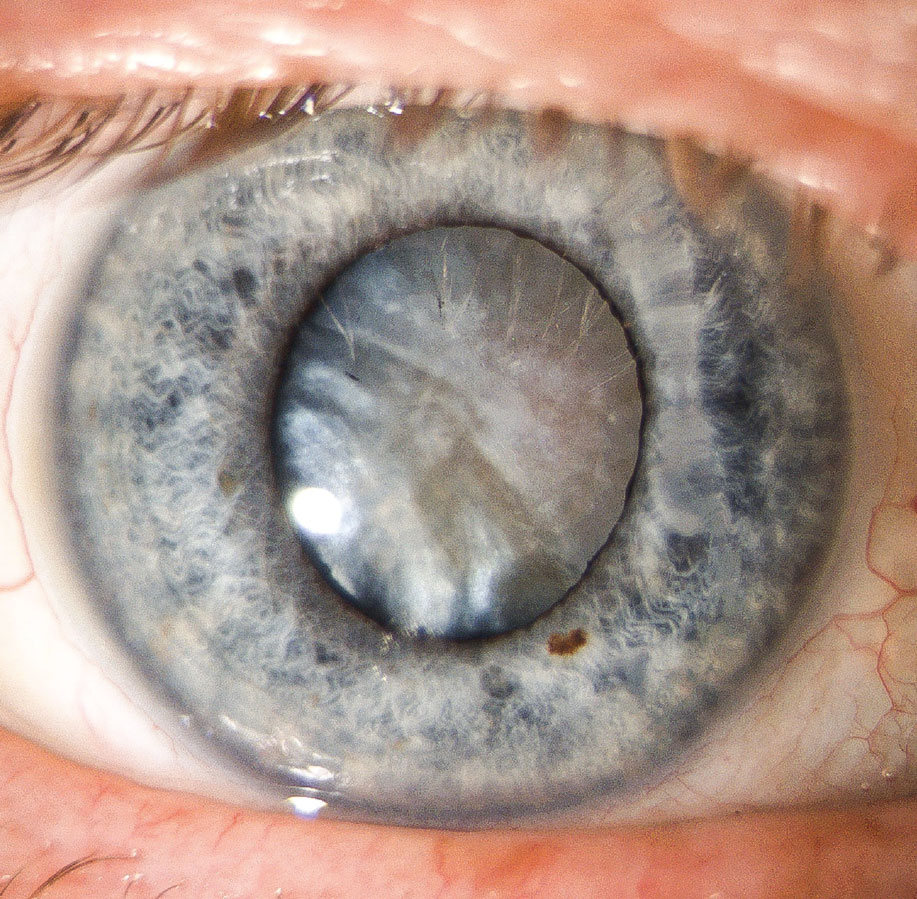 |
Existing research has associated obesity with greater cataract risk, but the current study revealed a novel U-shaped relationship between BMI and cataract risk only observed in women. Photo: Gleb Sukhovolskiy, OD. Click image to enlarge. |
While opacification of the lens has been extensively studied in terms of various potential risk factors, the contribution of sex differences has not yet been looked at in detail, according to Chinese researchers who elected to do so. The team pulled participants from the UK Biobank database to explore potential sex differences in the relationships between key social, lifestyle and physical health risk factors and incidence of cataracts between men and women. Results were recently published in the journal Eye.
The UK Biobank is a prospective cohort study of over 500,000 people aged 40 to 69 living in the UK, who were recruited between 2006 and 2010. Of these, 117,972 individuals did not have preexisting eye diseases. Cataract was diagnosed in 4,172 people (54.8% women) during follow-up. Per 10,000 person-years, crude incidence rate was 35.1 in women and 29.2 in men. Cataract incidence increased in both men and women with factors of Asian or Black ethnicity, smoking status, obesity, diabetes and myopia. In men, those who consumed alcohol or were unemployed had greater cataract risk when compared to their women counterparts. Conversely, women who had a high socioeconomic status, elevated blood pressure or metabolic syndrome had greater cataract risk than in men.
In their paper, the study authors discuss more specifics about their findings between sexes. At baseline, women were found to perform healthier lifestyle habits and physical conditions. The greater risk of cataract in men with unemployment status was a staggering 47% increased risk and 35% elevated risk with current alcohol consumption. Among women, elevated blood pressure resulted in a 63% higher risk of cataract and a 36% higher risk with metabolic syndrome.
Upon further elaboration, the authors explain that employment status significantly reduced cataract development risk in men. Socioeconomic status was also a key factor, with high status in men reducing cataract risk but women facing 31% increased risk of developing cataract with high status. Potential reasons for this observation may be inaccessibility to relative medical services and knowledge. Higher education in both sexes correlated with decreased risk and ethnicity affected cataract risk equally among both sexes.
Lifestyle factors were also studied and can be modifiable contributors in prevention. The difference in risk seen between men and women related to alcohol consumption may be due to alcohol type, drinking frequency and duration as well as presence of antioxidants in alcoholic beverages. Across both sexes, smoking consistently impacted people negatively in terms of risk. No sex differences were seen in risk associated with ultraviolet radiation or impact of exercise. The authors relay that “our study reveal similarities and differences in the impact of lifestyle on the incidence of cataract in different sexes, and further calls for people to cultivate good lifestyle habits to reduce the risk of cataracts.”
There was a tendency for hypertension to affect women more significantly, potentially because of harsher side effects of antihypertensive medications and lower adherence to treatment, as well as notable decline in estrogen levels post-menopause. This, along with the increased risk of cataract in women with metabolic syndrome, prompts the authors to impart that,
“given the increasing prevalence of metabolic syndrome globally and its profound health consequences, our findings emphasize the critical need for vigilant monitoring and proactive management of metabolic syndrome in women to mitigate their higher risk of cataracts.”
Xu Y, Liang A, Zheng X, et al. Sex-specific social, lifestyle, and physical health risk factors in cataracts development. Eye (Lond). July 29, 2024. [Epub ahead of print]. |


